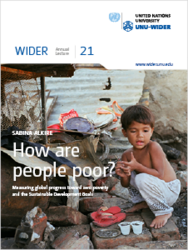WIDER Annual Lecture 21
How are people poor?
Measuring global progress toward zero poverty and the Sustainable Development Goals
In 2017 the WIDER Annual Lecture was given by Sabina Alkire. She discussed the implications of using the Global Multidimensional Poverty Index (MPI) and other poverty measures for achieving the United Nations 2030 Agenda for Sustainable Development, particularly Sustainable Development Goal 1 — to end poverty in all its forms everywhere.
Ending acute poverty is a matter of ethical importance and human urgency. It is a collective priority within and across nations and, most of all, for protagonists of poverty reduction. It is so because, despite fantastic gains, far too many continue to live in abject, dangerous, and harsh conditions, unable to shape lives with meaning and dignity.
Miguel Székely’s words well capture the motivation for improving statistics and measurement: their link to action. ‘A number’, he writes, ‘can awaken consciences; it can mobilize the reluctant, it can ignite action, it can generate debate; it can even, in the best of circumstances, end a pressing problem’ (Székely 2005, own translation).
This lecture steps back from many of the complexities of measurement and focuses on one aspect: poverty measurement. The value added and limitations of monetary poverty measures are well known (World Bank 2017). But a live question is whether we are able to use multidimensional poverty measures to expose a relevant, if limited, skeletal structure of poverty in such a way that clarifies the task of taking public action to address key aspects of poverty.
Naturally, the fundamental commitment is to poverty eradication, not to any particular skeletal arrangement. So, this lecture explores how a multidimensional structure of poverty measurement may, if well implemented, be of some use in eliminating poverty. The work presented here is not solely my own. The measurement methodology was developed with James Foster, a leading, precise, powerful, and powerfully disciplined mind across the field of poverty and inequality measurement. All empirical applications have been undertaken with researchers, students, and co-workers whose brilliance, care, and determination are nothing short of inspirational.
 Join the network
Join the network